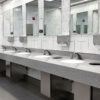At the 2009 Sino-American summit, President Obama committed the US to dispatching the head of NASA to China, in return for a reciprocal visit by his “appropriate Chinese counterpart,” i.e., a player to be named later. A year later, NASA Administrator Bolden has visited China (although it remains unclear to what end), yet there is no sign that an “appropriate Chinese counterpart” has even been designated.
This should be a warning sign, since China’s presence in space has been steadily improving. In 2010, China launched a record 15 satellites, the first time since the Cold War that any state has matched the rate of American launches in a year. In 2011, China will launch the Tiangong-1, a spacelab, and engage in docking maneuvers with their Shenzhou spacecraft. Meanwhile, China is striving to complete its indigenous Beidou navigation satellite system, a rival to the American GPS system, and is steadily outpacing Europe’s moribund Galileo program. And China’s network of Yaogan remote sensing satellites, capable of providing essential military intelligence, is also progressively expanding.
In light of the development of China’s anti-ship ballistic missile system, which PACOM Commander Admiral Robert Willard has said is now at initial operational capability (IOC), this space capability is of growing concern, since space systems are a key means for detecting and tracking US carrier battlegroups. Meanwhile, China’s greater international footprint, typified in its multi-year anti-piracy patrols in the Gulf of Aden, are likely to increase its reliance on space-borne communications.
At the same time, the ability of the United States to be able to undertake sustained surveillance of China is of growing importance, not least because China is steadily modernizing its nuclear as well as its conventional forces.
In this light, the Administration must act to safeguard its superiority in space. Chinese (and Russian) efforts at space arms control are often blatantly one-sided (such as forbidding space-based anti-satellite weapons, but not ground-launched systems such as the one China tested in 2007), and should be viewed with appropriate skepticism.
As the Administration looks beyond the summit with President Hu, it must recognize that not only will the United States and China interact on Earth, but increasingly it will do so in the heavens. American security has long rested on the ability to retain freedom of action in space; that will only become more pressing as China’s space presence increases.





























